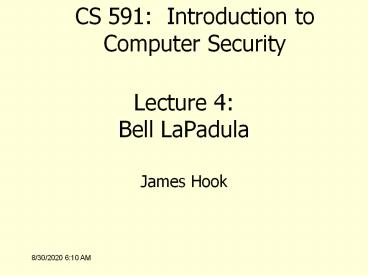Lecture 4: Bell LaPadula - PowerPoint PPT Presentation
Title:
Lecture 4: Bell LaPadula
Description:
Introduce the Bell LaPadula framework for confidentiality policy ... Proposed fix: tranquility. Strong: Labels never change during operation ... – PowerPoint PPT presentation
Number of Views:611
Avg rating:3.0/5.0
Title: Lecture 4: Bell LaPadula
1
Lecture 4Bell LaPadula
CS 591 Introduction to Computer Security
- James Hook
2
Objectives
- Introduce the Bell LaPadula framework for
confidentiality policy - Discuss realizations of Bell LaPadula
3
Follow Bishop
- Presentation follows Bishops slides for Chapter 5
4
Discussion
- When would you choose to apply a model this
restrictive?
5
Further Reading
- Ross Andersons Security Engineering, Chapter 7
Multilevel security - Standard Criticisms
- Alternative formulations
- Several more examples
- Looking Back at the Bell - La Padula Model,
David Elliott Bell, Proceedings 21st Annual
Computer Security Applications Conference,
December, 2005 - http//www.acsac.org/2005/papers/Bell.pdf
6
Criticisms of Bell LaPadula
- BLP is straightforward, supports formal analysis
- Is it enough?
- McLean wrote a critical paper asserting BLP rules
were insufficient
7
McLeans System Z
- Proposed System Z BLP (request for downgrade)
- User L gets file H by first requesting that H be
downgraded to L and then doing a legal BLP read - Proposed fix tranquility
- Strong Labels never change during operation
- Weak Labels never change in a manner that would
violate a defined policy
8
Historical
- The BLP retrospective published in December is
fascinating! - What we know as BLP and simple security was the
trivial case when labels didnt change. - Bell and La Padula expected to do a more dynamic
policy
9
Alternatives
- Goguen Meseguer, 1982 Noninterference
- Model computation as event systems
- Interleaved or concurrent computation can produce
interleaved traces - High actions have no effect on low actions
- The trace of a low trace of a system is the
same for all high processes that are added to
the mix - Problem Needs deterministic traces does not
scale to distributed systems
10
Nondeducibility
- Sutherland, 1986.
- Low can not deduce anything about high with 100
certainty - Historically important, hopelessly weak
- Addressed issue of nondeterminism in distributed
systems
11
Intranstitive non-interference
- Rushby, 1992
- Updates Goguen Meseguer to deal with the
reality that some communication may be authorized
(e.g. High can interefere with low if it is
mediated by crypto)
12
Looking forward
- Chapter 6 Integrity Policies

